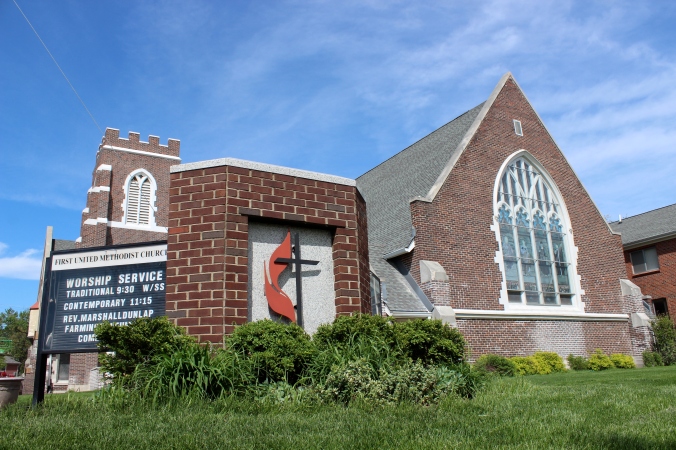The First United Methodist Church of Farmington holds several claims to fame. It is one of the state’s oldest Methodist congregations, formed in 1829, five years after Farmington’s first settlers arrived. Following a fire in 1920, a new worship center was commissioned from Butterfield & Butterfield, a father-daughter firm that included Michigan’s first licensed female architect. And the stained glass windows at the front of the sanctuary were donated by Fred Warner, Farmington’s only Michigan governor and the first to serve three consecutive terms.
In recognition of its heritage, the church has recently been named to the National Register of Historic Places, the official list of U.S. historic sites and structures deemed worthy of preservation.
DESIGNING A CHURCH
In 1922, a new church for Farmington was front-page news—especially for the Methodists, who had been holding services in the Baptist church since the 1920 fire. The original 1844 Methodist church, at the southeast corner of Warner and Shiawassee, had been a white frame building.
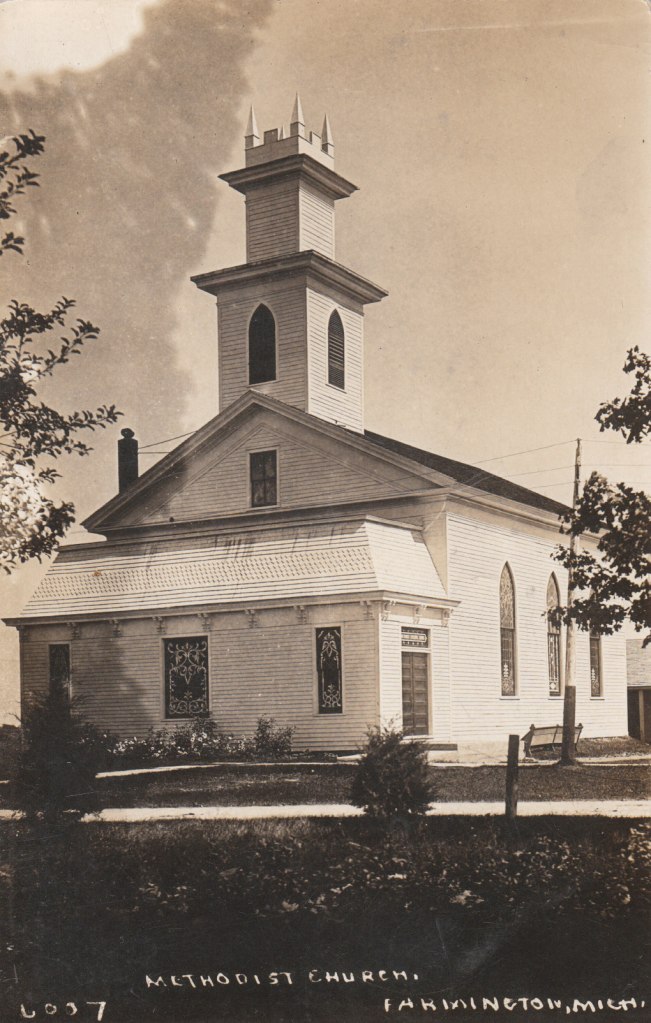
Farmington’s original Methodist church was completed in 1844. Courtesy of the Farmington Community Library.
In contrast, the new red-brick, Neo-Gothic structure featured a low roof, lofty tower, and curving stained glass windows. Inside, the sanctuary was furnished with pews and altar furniture of silver-gray.
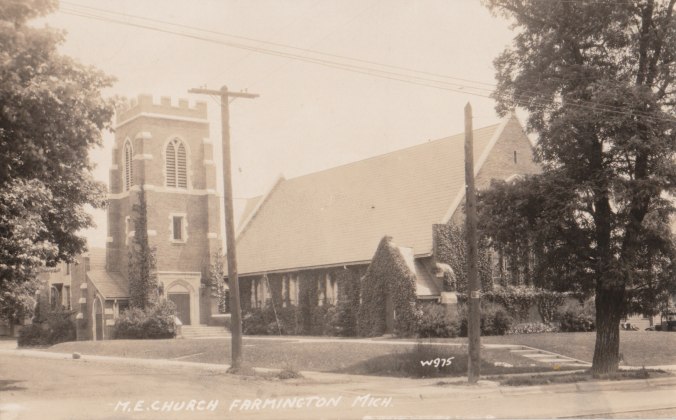
The 1922 Methodist church was designed by architects Wells and Emily Butterfield, both members of the congregation. Courtesy of the Farmington Community Library.
The Butterfield architects, who designed the church, were both members of the community—and its Methodist congregation. Wells Butterfield was Farmington’s first mayor. Emily was an artist and writer. Farmington was evidently proud of their work, with the Enterprise hailing it as “a structure of ecclesiastical beauty.”
WARNER MEMBERS
It’s likely that the Warner family followed the construction plans with interest. Fred Warner (governor from 1905-1911) and his wife, Martha, both attended the church and were married there in 1888.
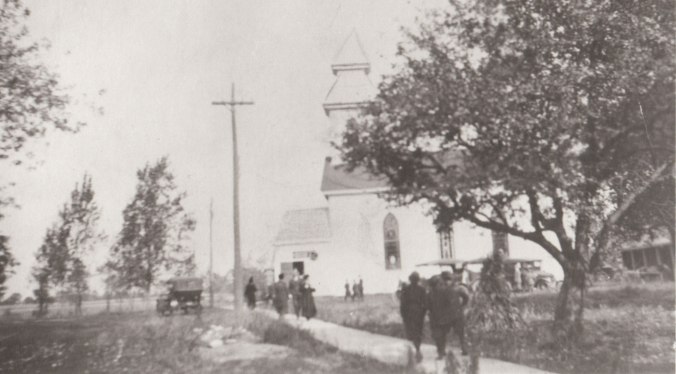
Members of the Methodist congregation tread a “boardwalk” on their way to worship at their original 1844 church. Courtesy of the Farmington Community Library.
The Warners were active church volunteers. Martha served as vice president of the Ladies Aid Society. Fred, a trustee, served on the building committee for the new church. But while church membership records list Martha as joining in March 1895, Fred’s name carries an interesting comment: “Not a member.”
The same was noted of his father, P. Dean, although the elder Warner had been a trustee as well as a Sunday school teacher. Members of the church’s historical committee speculate that the Warner men, both politicians, turned down official membership to distance themselves from the Methodists’ progressive and sometimes-controversial social policies around 1900.
WARNER WINDOWS
But Fred was a member in all but name. And, as a well-to-do businessman, he possessed the means to make a contribution toward the new church.
Fred and Martha’s gift remains as visible today as it was in 1922: four colorful stained-glass panels facing Grand River, dedicated in memory of P. Dean and Rhoda Warner (Fred’s parents), Samuel and Susan Davis (Martha’s parents), and Farmington’s early pioneers.
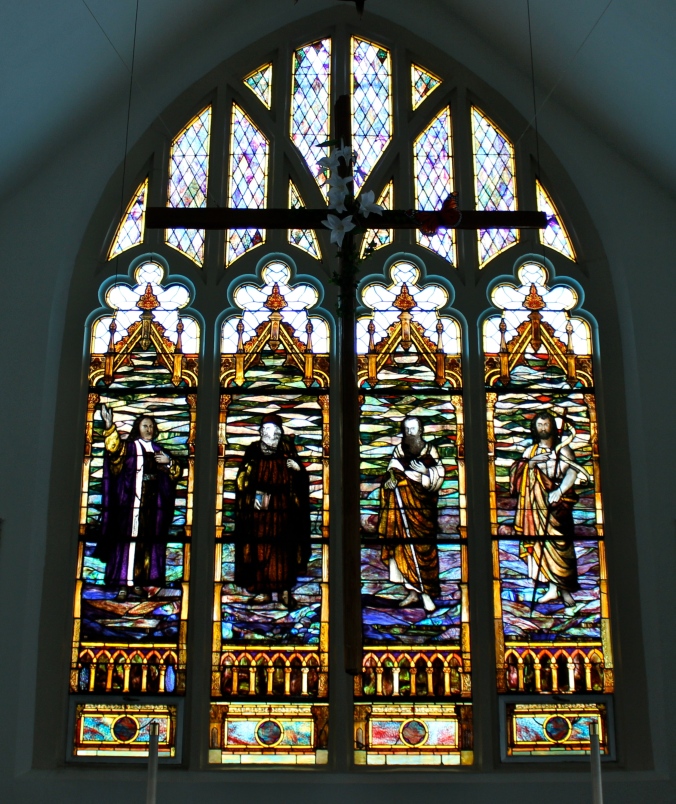
The stained glass panel at the front of Farmington’s current Methodist church was donated by Fred and Martha Warner in memory of their parents and the town’s early pioneers.
The windows were painted by French artist Francois Grenier and depict “Pioneers of Christendom”: St. John the Baptist, St. Paul, Bible translator John Wycliff, and Methodism founder John Wesley. According to the Enterprise, it was “one of the most beautiful church windows in the state.”
DEDICATION SERVICE
Clouds, rain, and chilly wind on dedication day—Sunday, March 19, 1922—didn’t dampen the spirits of attendees, who turned out enthusiastically to welcome the community’s new addition. Ceremonies opened with Holy Communion, followed by several services. Detroit Bishop Theodore Henderson conducted the dedication. As the first act of worship, the choir processed down the aisle, singing a hymn.
Festivities continued throughout the week, including a ladies’ social hour, a children’s party, a lecture on “Songs and Stories of Familiar Birds,” and a Ladies Aid Society banquet. Young People’s Night drew students from Farmington, Redford, and Northville for music by Albion College’s Alpha Tau Omega orchestra.
Even then, the buzz wasn’t over. On March 31, a local-news note read: “Afternoon Tea will be served at the home of Mrs. Howard Warner [Fred’s daughter-in-law] on Wednesday from 3 to 5 o’clock. A silver offering will be taken in behalf of the new Methodist church.”
MARKING THE PAST
At 10 a.m. this Sunday, May 31, the church will unveil a plaque marking its National Register designation.
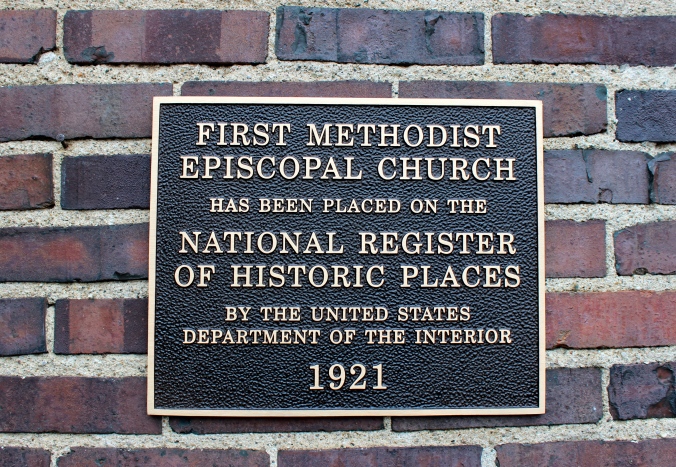
A plaque on the west side of Farmington’s Methodist church denotes its National Register of Historic Places designation.
Ninety-three years elapsed between Farmington’s first Methodists and the dedication of the 1922 church. Fittingly, its rededication as a historic landmark takes place another 93 years later.
